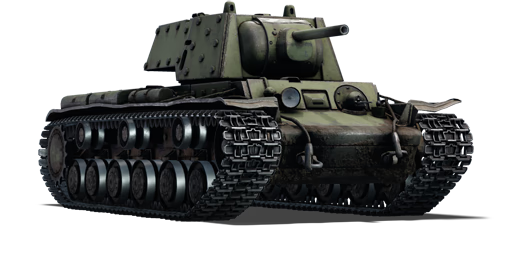


In 1940, a new variant of the venerable KV-1 heavy tank appeared on the frontlines of the Eastern front. This new KV had ditched its older, weak L-11 cannon in favour of a F-32 gun, similar to those found on the T-34s of the time. However, the biggest upgrade was its add-on armour. By riveting large steel plates to the hull's weakspots and the turret faces, the KV-1 suddenly became almost impenetrable to its enemies, with the German army having to call in air support or heavy towed 88 mm field guns every time one of these 1940 model KVs was encountered.
The KV-1E was introduced as a premium pack in Update 1.41.27. The KV-1E is characterized by its strong armour and decent mobility (for a heavy tank). As such, it can be quite the tough nut to crack for most opponents that it can face. The vehicle is best played aggressively, relying on its good armour to get close to the enemy, as its gun does not have the best penetration at range.
The KV-1E was removed after the 2018 Winter sale. It has since been made available for purchase in-game for Golden Eagles for specific Soviet/Russian mini-events like the "Defender of the Fatherland" and "Tankers' Day" in 2019, 2020, 2021 (twice), 2022, 2023, and 2024.
| Ammunition | Type | Armor penetration (mm) at a distance: | |||||
|---|---|---|---|---|---|---|---|
| 10 m | 100 m | 500 m | 1000 m | 1500 m | 2000 m | ||
| APHEBC | 77 | 76 | 69 | 62 | 55 | 49 | |
| Smoke | 3 | 3 | 3 | 3 | 3 | 3 | |
| HE | 11 | 11 | 10 | 10 | 10 | 10 | |
| Shrapnel | 35 | 34 | 30 | 25 | 22 | 18 | |
| APHEBC | 87 | 85 | 76 | 67 | 58 | 51 | |
| Belt | Belt filling | Armor penetration (mm) at a distance: | |||||
|---|---|---|---|---|---|---|---|
| 10 m | 100 m | 500 m | 1000 m | 1500 m | 2000 m | ||
| AP-I/API-T | 13 | 12 | 7 | 3 | 2 | 0 | |







 2 x (85 / 125 / 135) %
2 x (85 / 125 / 135) % 
 2 x 148 %
2 x 148 % 

Mobility | |
|---|---|
Protection |
|---|
Firepower | |
|---|---|